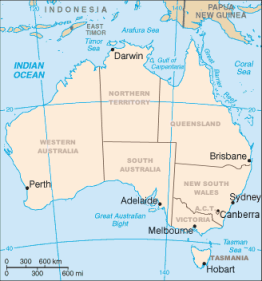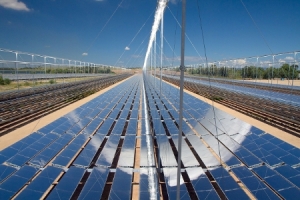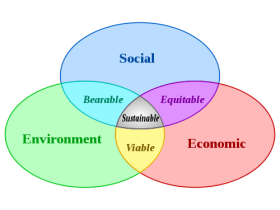Archive for the ‘Sustainability’ Category
Inclusive growth and climate change adaptation and mitigation in Australia and China: Removing barriers to solving wicked problems
 This reports aims to assist the Sino-Australian bilateral relationship adapt to meet China’s new policies and to facilitate a smoother transition to a low carbon future. Southwest University of Finance and Economics (SWUFE), Chengdu, China and the University of Queensland, Brisbane, Australia held a workshop at SWUFE to develop a guide to China’s low-carbon policies and their implications for the Sino-Australian energy trade and sectors. This report results from the workshop. Chapter 3 contains the guide to China’s low emission policies and discusses market-based experiments within China’s command-and-control electricity sector. Chapter 4 discusses Australia’s poorly implemented neoliberal policies within its energy sector and provides an informative market-based case study for China on what to avoid. Chapter 2 discusses the implications of Australia and China’s low emission policies. Chapter 5 discusses barriers to the transition to a low emissions economy.
This reports aims to assist the Sino-Australian bilateral relationship adapt to meet China’s new policies and to facilitate a smoother transition to a low carbon future. Southwest University of Finance and Economics (SWUFE), Chengdu, China and the University of Queensland, Brisbane, Australia held a workshop at SWUFE to develop a guide to China’s low-carbon policies and their implications for the Sino-Australian energy trade and sectors. This report results from the workshop. Chapter 3 contains the guide to China’s low emission policies and discusses market-based experiments within China’s command-and-control electricity sector. Chapter 4 discusses Australia’s poorly implemented neoliberal policies within its energy sector and provides an informative market-based case study for China on what to avoid. Chapter 2 discusses the implications of Australia and China’s low emission policies. Chapter 5 discusses barriers to the transition to a low emissions economy.
Climate change is one of the world’s major challenges. Others include increasing inequality and poor economic growth, creating a decline in inclusive growth. Declining inclusive growth and climate change are interrelated wicked problems. Their solution is technically and economically viable given appropriate investment but the absence of a price on carbon in Australia is a major obstacle to directing investment consistent with a low emissions future.
Australia is transitioning from a mining to a more service orientated economy. However, Australia’s uncoordinated energy and climate change policy and poorly implemented neoliberal policies in the energy sector are undermining investment confidence and hindering both inclusive growth and the transition to a lower emissions economy. Energy and climate change policies need bring together to restore investment confidence within the electricity sector. The Integrated Systems Plan has gone some way to address this problem. Similarly, Australia’s uncoordinated growth and climate change policies are hindering inclusive growth and the transition to a lower emissions economy. Growth and climate change policies need bringing together to engender confidence and direct investment compatible with a low emissions future. Notably, Infrastructure Australia has gone some way to address this issue at the national level but the lack of transparency and independence in other jurisdictions undermines Infrastructure Australia’s effectiveness.
Poor policy coordination is also hindering solutions to a host of other interrelated wicked problems. These wicked problems include massive increases in retail electricity prices, private school fees and private health insurance, the inability to undertake major tax reform, such as introducing a tax on sugar or carbon or introduce road user charges to replace the declining revenue from fuel excise duty. There is ample and sound evidence-based research to solve these wicked problems but there is an inability to enact policy in the interest of the electorate.
The key findings of this report are four common barriers to enacting policy to solve these wicked problems.
(1) Political donations present a conflict of interest.
(2) Adversarial politics and political wedging reduce the ability to address complex problems.
(3) There is an absence of academic economists informing the public debate to provide impartial advice.
(4) Unrealistic models of the economy and human behaviour are misinforming policy.
Collinsville solar-gas hybrid project: meeting the climate change challenge by combing proven technologies in a new way and reusing existing infrastructure
RATCH Australia (RAC 2013) in conjunction with the University of Queensland (UQ) are researching the feasibility of a hybrid gas-concentrated solar power (CSP) plant using Linear Fresnel Reflector (LFR) technology to replace the coal fired power station at Collinsville, Queensland, Australia. The project is supported by the Australian Renewable Energy Agency (ARENA) and administered by the Global Change Institute at UQ.
Both the gas generation and LFR technology are proven technologies and both boil water to drive a generator to produce power. The LFR uses ground level mirrors to concentrate the suns energy onto a higher re-concentrator mirror that focuses the energy onto a pipe containing water to produce steam for the generator, see Figure 1.
Figure 1: Concentrated Linear Fresnel Reflector
The combined gas-solar plant allows the plant to maintain a constant electricity output because the gas boiler operates when the sun does not shine. Table 1 shows the proposed electricity output by hour of week. This constant electricity power output during the week avoids the variability of solar generation, which allows the plant to operate as a baseload plant in a similar way to coal-fired power stations. Both the solar boiler and gas boiler can use the same generator therefore saving on capital investments. A team from the School of Mining and Mechanical Engineering are researching issues surrounding duel boiler use of the same generator (Singh & Gurgenci 2014). Another team is investigating techniques to keep the mirrors clean (Guan, Yu & Gurgenci 2014).
Table 1: Proposed plant’s total electricity output by hour of week
| Time | Dispatch (MW) |
| Weekdays: 8am-10pm | 30 |
| Weekdays: 7am-8am | ramp from 0 to 30 |
| Weekends | entire yield of the solar thermal component |
(Source: Bell, Wild & Foster 2014a)
The transmission lines to connect a generator to the electricity grid can cost a million dollars or more a kilometre, therefore reusing the existing transmission lines at Collinsville is not only a major savings in capital investment but saves on producing CO2 emissions that would otherwise be required to produce the steel and other metals for connection to the grid. A team from the School of Information Technology and Electrical Engineering are researching grid stability issues (Shah, Yan & Saha 2014).
This project provides a template for future hybrid schemes because Australia’s ageing coal-fired power stations are close to retirement and their grid connections will become available to similar renewable schemes. The hybrid schemes also allow the transition and retraining of fossil people into renewable people.
A team from the Energy Economics and Management Group, School of Economics is forecasting the lifetime yield of the solar plant (Bell, Wild & Foster 2014b) and revenue and dispatch of the plant (Bell, Wild & Foster 2014a). These forecasts both help determine the financial feasibility of the plant and help secure a power purchase agreement for the power produced. Seven ‘Collinsville solar thermal project’ reports are due for publication in November or December this year; the draft reports were due in May this year. Please correspond with the authors if you have any questions.
References
Guan, Z, Yu, S & Gurgenci, H 2014, Collinsville solar thermal project: Solar mirror cleaning requirements, University of Queensland, Brisbane, Australia.
Novatec Solar 2014, ‘Novatec Solar’, viewed 12 Jul 2014 <http://www.novatecsolar.com/20-1-Nova-1.html>.
RAC 2013, ‘Collinsville Energy Park’, RATCH-Australia Corporation Limited, <http://ratchaustralia.com/Collinsville%20Energy%20Park.html>.
Shah, R, Yan, R & Saha, T 2014, Collinsville solar thermal project: Power system assessment, University of Queensland, Brisbane, Australia.
Singh, R & Gurgenci, H 2014, Collinsville solar thermal project: Fossil fuel boiler integration, University of Queensland, Brisbane, Australia.
The impact of a carbon price on electricity prices in Australia
 The University of Queensland News discusses the study ‘The Impact of Carbon Pricing on Wholesale Electricity Prices, CarbonPass-Through Rates and Retail Electricity Tariffs in Australia‘, stating that the study is the most accurate estimate to date for the impact of the carbon price on retail electricity prices and reveals the burden will vary considerably, depending on a household’s location.
The University of Queensland News discusses the study ‘The Impact of Carbon Pricing on Wholesale Electricity Prices, CarbonPass-Through Rates and Retail Electricity Tariffs in Australia‘, stating that the study is the most accurate estimate to date for the impact of the carbon price on retail electricity prices and reveals the burden will vary considerably, depending on a household’s location.
Tasmanians, with a relatively low carbon footprint, are set to gain significantly from the carbon price once tax and pension changes are factored in, while Queenslanders — heavily dependent on coal to generate electricity — will wear the biggest increase in power prices, according to economic models run on “supercomputers” at The University of Queensland.
The study estimates an average 8.9 per cent increase for retail electricity prices in the five eastern states, due to the carbon price — below the 10 per cent rise estimated by the federal Treasury. This runs counter to claims that Treasury has underestimated the impact of the carbon price on the economy. Read the rest of this entry »

